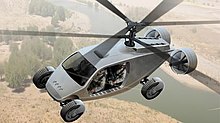From Wikipedia, the free encyclopedia
| DARPA TX (Transformer) | |
|---|---|
| Type | Flying car |
| Place of origin | |
| Specifications | |
| Length | >30 ft (910 cm)[1] |
| Width | >8.5 ft (260 cm)[1] |
| Height | >9 ft (270 cm)[1] |
| Crew | 4[1] |
|
|
|
| Payload capacity | 1,000 lb (450 kg)[1] |
| Operational range |
250 NM (460 km)[1] |
The objective of the Transformer (TX) program is to demonstrate a four person vehicle that provides enhanced logistics and mobility though hybrid flyable/roadable capabilities. This presents unprecedented capability to avoid traditional and asymmetrical threats while avoiding road obstructions. TX will enable enhanced company operations of future missions with applicable use in strike and raid, intervention, interdiction, insurgency/counterinsurgency, reconnaissance, medical evacuation and logistical supply. The TX vehicle will have Vertical Takeoff and Landing (VTOL) capability with a minimum combat range of 250 nautical miles on a single tank of fuel.
The primary focus of the TX program will be the development and demonstration of an integrated suite of critical technologies that enable dual-mode transportation, VTOL capability, efficient flight performance, and a combat range comparable to present day rotorcraft. It is envisioned that this program will, at a minimum, demonstrate the ability to build a ground vehicle that is capable of configuring into a VTOL air vehicle that provides sufficient flight performance and range, while carrying a payload that is representative of four troops with gear. Key performance parameters have been specified to show specific operational utility. The program will be divided into two separate tasks. Task A will develop and integrate a full vehicle and Task B will develop individual critical technologies components for the full vehicle.
Russia will develop a similar vehicle for the Russian Airborne Troops. The vehicle will be a hybrid of a light combat vehicle and an attack helicopter with a crew of three-four people, and be developed by 2030.[3]
Contents
Function
The Marines, Air Force, special forces[4] and National Guard[5] have stated an interest in the vehicle. Marines may use the Transformer as a tool for the Enhanced Company Operations concept.[6]The Marines would use the vehicle for amphibious assault and potentially eliminate the need for amphibious vehicles which are vulnerable to shore defenses and limited by their low speeds.[4] Special ops would like to send vehicles unmanned to resupply special operators and then allow them to use that vehicle.[4]
Design
- Mobility
- Offensive capabilities
- Countermeasures
Development
- Conception
- Phase I
No more than 2 contracts were to be awarded in the $65m Phase I.[9][1] In September however only AAI's proposal was selected,[10] for $3m.[11] This proposal builds on the CarterCopter slowed rotor technology,[12][13][14] and incorporates deployable surfaces technology from Terrafugia.[15][16] The United States Army Research Laboratory (Vehicle Technology Directorate) was contracted to conduct rotor analysis. Other partners are Bell Helicopter and Textron Marine & Land Systems, sister companies of AAI and subsidiaries of Textron. Lockheed Martin, Piasecki Aircraft, Ricardo Inc., Carnegie Mellon University, Pratt & Whitney Rocketdyne, Aurora Flight Sciences, ThinGap, Terrafugia and Metis Design are also connected to the project.[9]
In October 2010, Lockheed Martin and its partners were also connected to Phase 1 of the program.[8]
Pratt & Whitney Rocketdyne has received a US$1 million contract[11] to develop a Diesel engine called Enduro Core to power the Transformer.[17]
- Phase II — Design
The 7,500 lb AAI vehicle is proposed to be equipped with a 1,200 shp Honeywell HTS900 turboshaft engine to power four electric wheel motors or the 56-inch ducted fan, and spin up the 50-foot rotor. Ground speed is up to 80 mph; flight speed range is 50 to 155 kt; maximum altitude is 10,000 ft.
The 7,000lb Lockheed vehicle has two turboshaft engines in a 41 ft wing with tilting 8.5 ft ducted fans, giving a flight speed of 130 kt, while a Pratt & Whitney EnduroCore heavy-fuel rotary engine powers the four electric wheel motors for ground motion.
At AUVSI 2012, Lockheed Martin spoke openly about their status on the project. AAI Corporation was silent about their involvement details, but confirmed they were still in the competition. At the time of expo, neither company had prototype vehicles, but had designs and scale models of their concept vehicles. Previously, both passed DARPA's preliminary design review, which involved computer modeling. Lockheed's vehicle relies on two huge turbo-shaft fans and folding wings fixed to a turret above the cab to provide lift and thrust during flight. A key component is computerized flight. Because it will be used by soldiers rather than trained pilots, vehicle operation will be mostly automated. One idea is to have a computer screen to simply plot GPS points to chart a flight path. The fans will rotate 90 degrees on the turret from their stowed positions just in front of and behind the cab to their in-flight positions on both sides of it. Control of takeoff, landing, and flight is controlled by the computer, although soldiers onboard would be able to alter their course or perform an emergency landing. The automated flight technology will be similar to the kind used by the F-35 Lightning II. The lift fans of Lockheed's vehicle provide hover while AAI's does not. AAI's vehicle can be made lighter, which gives greater ability to up-armor.[18]
- Phase III — Manufacture of the prototype.[2]
Previous concepts
AVX Aircraft Company proposed a concept with coaxial rotors. Ducted fans were intended as propulsion in air as well as on ground.[20]Logi and Trek offered the Tyrannos, a tilt-fan vehicle.[21]


No comments:
Post a Comment